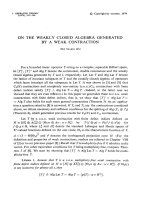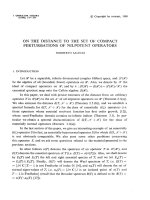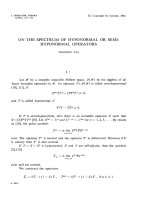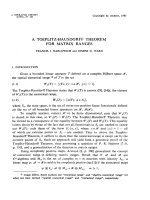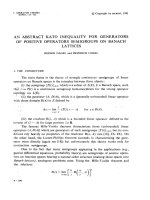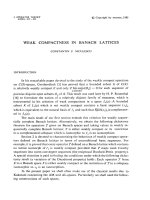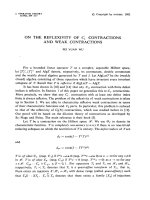Báo cáo toán học: "On the function “sandwiched” between α(G) and χ(G) V. Y" ppt
Bạn đang xem bản rút gọn của tài liệu. Xem và tải ngay bản đầy đủ của tài liệu tại đây (52.63 KB, 3 trang )
On the function “sandwiched” between α(G) and χ(G)
V. Y. Dobrynin
1
Submitted: July 18, 1997; Accepted: September 2, 1997
Abstract
A new function of a graph G is presented. Say that a matrix B that is indexed by vertices of G
is feasible for G if it is real, symmetric and I ≤ B ≤ I + A(G), where I is the identity matrix and
A(G) is the adjacency matrix of G. Let B(G) be the set of all feasible matrices for G, and let
χ(G)
be the smallest number of cliques that cover the vertices of G. We show that
α(G) ≤ min{ rank(B) |B ∈B(G)}≤
χ(G)
and that α(G) = min{ rank(B) |B ∈B(G)}implies α(G)=
χ(G).
The well known Lov´asz number ϑ(G) of a graph G [1] is “sandwiched” between the size of the
largest stable set in G and the smallest number of cliques that cover the vertices of G
α(G) ≤ ϑ(G) ≤
χ(G).
Some alternative definitions of ϑ(G) are introduced in [2][3] . For example,
ϑ(G) = max{ Λ(B) |B is a real positive semidefinite matrix
indexed by vertices of G,
B
vv
= 1 for all v ∈ V (G),
B
uv
= 0 whenever u −− v in G},
where Λ(B) is the maximum eigenvalue of B, V (G) — the set of vertices of G, u −− v denotes the
adjacency of vertices u and v.
Call the matrix B indexed by vertices of G feasible for G if
B is real and symmetric,
B
vv
= 1 for all v ∈ V (G),
B
uv
= 0 whenever u −− v in G,
0 ≤ B
uv
≤ 1 whenever u −− v in G.
Let B(G) be the set of all feasible matrices for G. Then [4]
χ(G) = min{ rank(B) |B ∈B(G),B =C
T
C, C ≥ 0},
where the inequality denotes componentwise inequality.
The aim of this paper is to study a new function of graph G
the electronic journal of combinatorics 4 (1997), #R19 2
Theorem. For all graphs G
α(G) = min{ rank(B) |B ∈B(G)}
implies α(G)=
χ(G).
Proof. Let S = {v
1
,v
2
, ,v
α(G)
} be the stable set of G, S = V (G) \ S and B ∈B(G) is a matrix
such that rank(B)=α(G). We can assume that
B =
I
α(G)
X
X
T
Y
,
where I
α(G)
is the identity α(G) × α(G)-matrix.
Applying block Gauss elimination, B reduces to the matrix
B
=
I
α(G)
X
0 Y − X
T
X
.
We have
Y − X
T
X =0
or
Y
uv
−
w∈S
X
wu
X
wv
=0,u,v∈S (1)
since rank(B
) = rank(B)=α(G).
Equation (1) gives us further information about the graph G.
(i) If v ∈
S then exists u ∈ S such that u −− v. Indeed, Y
vv
= 1 and X
wv
≥ 0 for all w ∈ S.
Hence,
w∈S
X
2
wv
= 1 and X
uv
> 0 for some u ∈ S.
(ii) If v
,v
∈ S and X
uv
X
uv
> 0 for some u ∈ S then v
−− v
. Indeed, if
w∈S
X
wv
X
wv
> 0
then Y
v
v
> 0.
Let
V
u
= {u}∪{v|v∈S,X
uv
> 0}
for all u ∈ S and G(V
u
) be the subgraph induced from G by leaving out all vertices except vertices
from V
u
. We know from (i) and (ii) that G(V
u
) is a clique and V (G)=∪
u∈S
V
u
.Hence, χ(G)=
α(G).
Corollary. If χ(G) ≤ α(G)+1 then
χ(G) = min{ rank(B) |B ∈B(G)}.
For example, consider the Petersen graph G. We have α(G)=ϑ(G)=4,
χ(G)=5.Hence,
min{ rank(B) |B ∈B(G)}=5.
There is a graph G such that
α(G) < min{ rank(B) |B ∈B(G)}<
χ(G).
Let V (G)=2
{1,2,3,4,5,6}
and u −− v iff 2 ≤|(u\v)∪(v\u)|≤5 for all u, v ∈ V (G). Then [5]
χ(G) = 32 and rank(A(G)) = 29 where A(G) is the adjacency matrix of G. Then
χ(G)=32and
the electronic journal of combinatorics 4 (1997), #R19 3
and
α(G) < min{ rank(B) |B ∈B(G)}
by theorem.
Acknowledgement.
The author is grateful to the anonymous referee for valuable remarks.
References
1. L. Lov´asz, “On the Shannon capacity of a graph”, IEEE Transactions on Information Theory
IT–25 (1979), 1–7.
2. Martin Gr¨otschel, L´aszl´oLov´asz, and Alexander Schrijver, Geometric Algorithms and Combina-
torial Optimization (Springer-Verlag, 1988).
3. Donald E.Knuth, “The Sandwich Theorem”, Electronic J. Combinatorics 1, A1 (1994), 48 pp.
4. V.Y.Dobrynin, “The chromatic number of a graph and rank of matrix associated with it”, Vestnik
Sankt-Peterburgskogo Universiteta, Ser.1, Issue 2, Vol.15 (1995), 120–122.
5. N.Alon, P.D.Seymour. “A counterexample to the rank-coloring conjecture”, Journal of Graph
Theory 13 (1989), 523–525.
